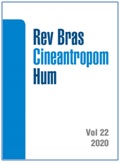Effect of small-sided games with manipulation of small targets on the perceived exertion and tactical and technical performance of college soccer players
DOI:
https://doi.org/10.1590/1980-0037.2020v22e57958Abstract
The purpose of this study was to compare the tactical and technical performance and perceived exertion of college soccer players in small-sided games through the manipulation of small targets. Twenty players divided into four teams, played 5x5 games (25x20 m) with one and two small targets on different days. Games were divided into three four-minute times, with two-minute intervals between bouts. Perceived exertion and technical-tactical variables were evaluated using Ball Transmission Speed (ball received/ball contacts) and Team Sport Assessment Procedure (TSAP). TSAP generates performance indicators, such as: efficiency index, performance score, volume of play and ball attack. They are related to the actions of balls conquered, passes and finalizations. For statistical analysis, paired t test and Cohen’s d effect size were performed to compare the two game configurations. Larger number of balls conquered with small target was verified (p<0.05; d=1.32), generating higher efficiency index and performance score. It was concluded that the perceived exertion is similar with one and two small targets and players recover more balls with only one small target. Through this information, coaches can better handle this type of constraints according to the purpose of the training session.References
Goodman AD, Etzel C, Raducha JE, Owens BD. Shoulder and elbow injuries in soccer goalkeepers versus field players in the National Collegiate Athletic Association, 2009–2010 through 2013–2014. Phys Sportsmed 2018;46(3):304-311.
Orloff H, Sumida B, Chow J, Habibi L, Fujino A, Kramer B. Ground reaction forces and kinematics of plant leg position during instep kicking in male and female collegiate soccer players. Sports Biomech 2008;7(2):238-247.
Peart AN, Nicks CR, Mangum M, Tyo BM. Evaluation of Seasonal Changes in Fitness, Anthropometrics, and Body Composition in Collegiate Division Ii Female Soccer Players. J Strength Cond Res 2018;32(7):2010-2017.
Sharma SK, Raza S, Moiz JA, et al. Postactivation Potentiation Following Acute Bouts of Plyometric versus Heavy-Resistance Exercise in Collegiate Soccer Players. Biomed Res Int 2018;2018:1-8.
Aguiar M, Botelho G, Lago C, Maças V, Sampaio J. A review on the effects of soccer small-sided games. J Hum Kinet 2012;33:103-113.
Vilar L, Esteves PT, Travassos B, Passos P, Lago-Peñas C, Davids K. Varying numbers of players in small-sided soccer games modifies action opportunities during training. Int J Sports Sci Coach 2014;9(5):1007-1018.
Castellano J, Silva P, Usabiaga O, Barreira D. The influence of scoring targets and outer-floaters on attacking and defending team dispersion, shape and creation of space during small-sided soccer games. J Hum Kinet 2016;51(1):153-163.
Casarin RV, Reverdito RS, de Lima Greboggy D, Afonso CA, Scaglia AJ. Modelo de jogo e processo de ensino no futebol: princípios globais e específicos. Movimento 2011;17(3):133-152.
Práxedes A, Moreno A, Gil-Arias A, Claver F, Del Villar F. The effect of smallsided games with different levels of opposition on the tactical behaviour of young footballers with different levels of sport expertise. PloS One 2018;13(1):e0190157.
Ometto L, Vasconcellos FVA, Cunha FA, et al. How manipulating task constraints in small-sided and conditioned games shapes emergence of individual and collective tactical behaviours in football: A systematic review. Int J Sports Sci Coach 2018;0(0):1-15.
Borg G. Borg’s perceived exertion and pain scales. Human kinetics; 1998.
Gréhaigne J-F, Godbout P, Bouthier D. Performance assessment in team sports. J Teach Phys Educ 1997;16(4):500-516.
Dugrand M. Football, de la transparence à la complexité. Presses universitaires de France; 1989.
Rosenthal JA. Qualitative descriptors of strength of association and effect size. J Soc Serv Res 1996;21(4):37-59.
Brandes M, Müller L, Heitmann A. Physiological responses, time–motion characteristics and game performance in 4 vs. 4 small-sided games in elite youth soccer players: different number of mini-goals vs. stop-ball. Sci Med Foot 2017;2(1):1-6.
Halouani J, Chtourou H, Dellal A, Chaouachi A, Chamari K. Physiological responses according to rules changes during 3 vs. 3 small-sided games in youth soccer players: stop-ball vs. small-goals rules. J Sports Sci 2014;32(15):1485-1490.
Clemente FM, Wong DP, Martins FML, Mendes RS. Acute effects of the number of players and scoring method on physiological, physical, and technical performance in small-sided soccer games. Res Sports Med 2014;22(4):380-397.
Almeida CH, Duarte R, Volossovitch A, Ferreira AP. Scoring mode and age-related effects on youth soccer teams’ defensive performance during small-sided games. J Sports Sci 2016;34(14):1355-1362.
Travassos B, Gonçalves B, Marcelino R, Monteiro R, Sampaio J. How perceiving additional targets modifies teams’ tactical behavior during football small-sided games. Hum Mov Sci 2014;38:241-250.
Moraes EL, Cardoso F, Teoldo I. Análise dos padrões ofensivos da Seleção Espanhola de Futebol na Copa do Mundo FIFA® 2010 em relação ao” status” da partida. Rev Bras Educ Fís Esp 2014;28(3):361-369.
Santos R, Moraes E, Teoldo I. O status da partida e a amplitude de circulação da bola da seleção espanhola de futebol na Copa do Mundo Fifa® 2010. Rev Bras Ciênc Esporte 2016;38(4):358-362.



